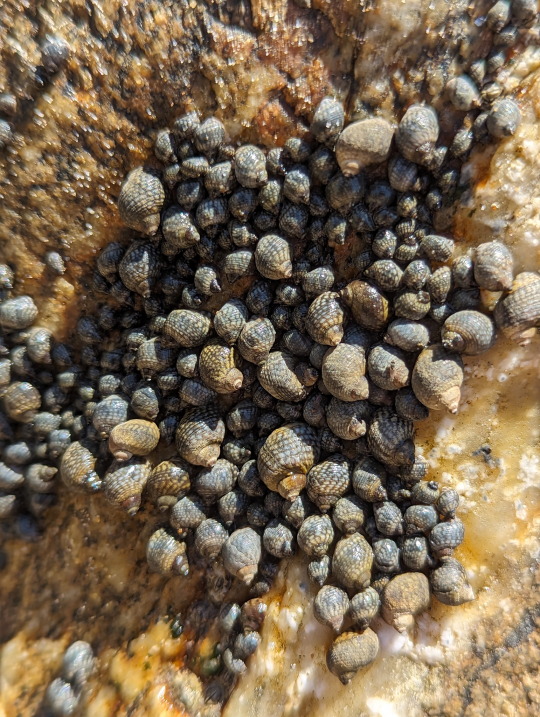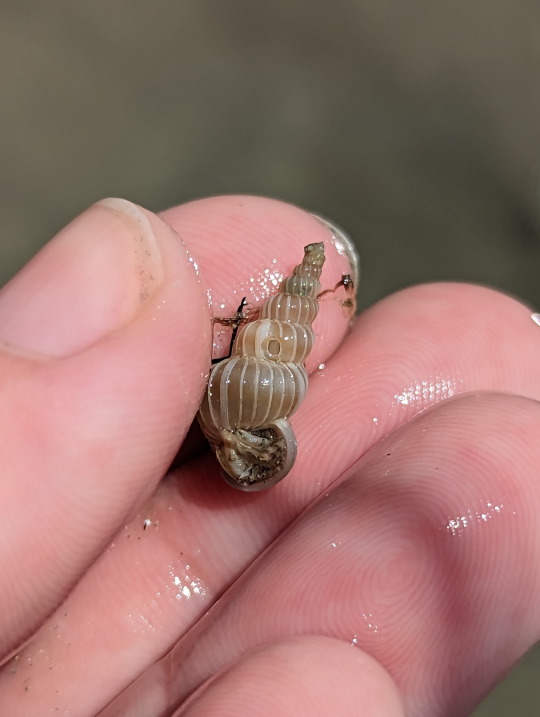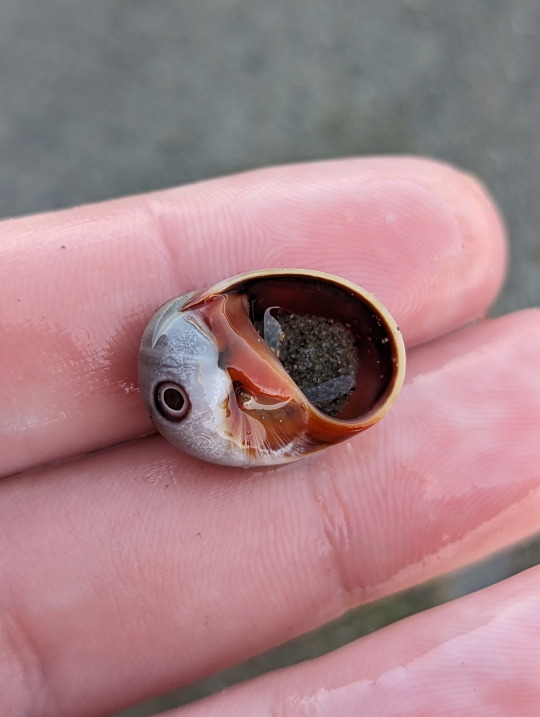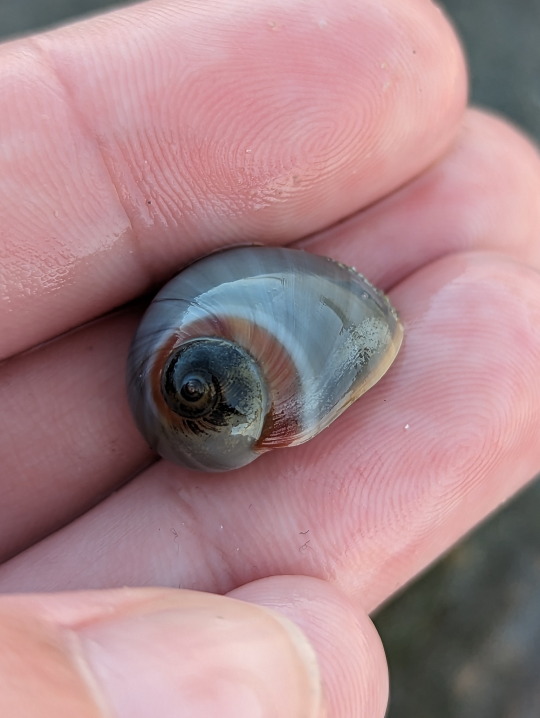#periwinkle snails
Explore tagged Tumblr posts
Text
Uncharismatic Fact of the Day
Identifying species can be an extremely difficult job for biologists-- especially when the animal in question has too few distinguishing features, or too many. Perhaps no species demonstrates this better than Littorina saxatilis, aka the rough periwinkle snail. Due to the extreme variations in shell shape, size, and color, this species has been misidentified by taxonomists 112 times! Even today, scientists are still in dispute over whether genetically distinct populations should be considered separate species.

(Image: Six rough periwinkle snails (Littorina saxatilis) by Sue Scott)
Want to request some art or uncharismatic facts? Just send me proof of donation of any amount to any of the fundraisers on this list, or a Palestinian organization of your choice!
Bonus: check out the list of L. saxatilis' former names below the cut!
Litorina groenlandica Menke, 1830
Litorina incarnata Philippi, 1846
Litorina marmorata L. Pfeiffer, 1839
Litorina sulcata Menke, 1830
Littorina castanea Deshayes in Deshayes & Milne Edwards, 1843
Littorina danieli Locard, 1886
Littorina groenlandica (Menke, 1830)
Littorina neglecta Bean, 1844
Littorina nervillei Dautzenberg, 1893
Littorina nervillei var. major Pallary in Seurat, 1924
Littorina nigrolineata Gray, 1839
Littorina palliata var. turritella Schlesch, 1916
Littorina rudis (Maton, 1797) (synonym)
Littorina rudis f. elatior Middendorff, 1849
Littorina rudis var. albida Dautzenberg, 1887
Littorina rudis var. alticola Dacie, 1917
Littorina rudis var. aurantia Dautzenberg, 1887
Littorina rudis var. brevis Dautzenberg, 1887
Littorina rudis var. conoidea Schlesch, 1916
Littorina rudis var. fasciata Dautzenberg, 1887
Littorina rudis var. finmarchia Herzenstein, 1885
Littorina rudis var. globosa Jeffreys, 1865
Littorina rudis var. globosa Martel, 1901
Littorina rudis var. laevis Jeffreys, 1865
Littorina rudis var. major Dautzenberg & P. Fisher, 1912
Littorina rudis var. rubescens Monterosato, 1878
Littorina rudis var. scotia S.M. Smith, 1979
Littorina rudis var. similis Jeffreys, 1865
Littorina rudis var. sulcata Martel, 1901
Littorina rudis var. tenebrosapallida L.E. Adams, 1896
Littorina rudis var. tessellata Dautzenberg, 1893
Littorina saxatile La Roque, 1953
Littorina saxatile saxatile La Roque, 1953
Littorina saxatilis Johnston, 1842
Littorina saxatilis f. abbreviata Dautzenberg & P. Fisher, 1912
Littorina saxatilis f. conoidea Dautzenberg & P. Fisher, 1912
Littorina saxatilis f. elongata Dautzenberg & P. Fisher, 1912
Littorina saxatilis f. minor Dautzenberg & P. Fisher, 1912
Littorina saxatilis groenlandica (Menke, 1830)
Littorina saxatilis groenlandica var. sculpta Schlesch, 1931
Littorina saxatilis jugosa Montagu, 1803
Littorina saxatilis jugosa var. bynei Dautzenberg & P. Fisher, 1912
Littorina saxatilis jugosa var. tenuis James, 1968
Littorina saxatilis nigrolineata Gray, 1839
Littorina saxatilis rudis (Maton, 1797)
Littorina saxatilis rudis var. rudissimoides James, 1968
Littorina saxatilis scotia Graham, 1988
Littorina saxatilis tenebrosa (Montagu, 1803)
Littorina saxatilis tenebrosa var. biinterrupta Fischer-Piette & Gaillard, 1963
Littorina saxatilis tenebrosa var. bizonaria James, 1963
Littorina saxatilis tenebrosa var. elata Dautzenberg & P. Fisher, 1912
Littorina saxatilis tenebrosa var. maculata Fischer-Piette & Gaillard, 1963
Littorina saxatilis var. clarilineata Fischer-Piette & Gaillard, 1971
Littorina saxatilis var. flammulata Dautzenberg & P. Fisher, 1912
Littorina saxatilis var. fulva Dautzenberg & P. Fisher, 1912
Littorina saxatilis var. fusca Dautzenberg & P. Fisher, 1912
Littorina saxatilis var. gascae Fischer-Piette & Gaillard, 1971
Littorina saxatilis var. groenlandica (Menke, 1830)
Littorina saxatilis var. hieroglyphica Fischer-Piette, Gaillard & Jouin, 1961
Littorina saxatilis var. interrupta Fischer-Piette, Gaillard & Jouin, 1961
Littorina saxatilis var. lagunae Barnes, 1993
Littorina saxatilis var. lineata Dautzenberg & P. Fisher, 1912
Littorina saxatilis var. lugubris Dautzenberg & P. Fisher, 1912
Littorina saxatilis var. nigra Fischer-Piette & Gaillard, 1971
Littorina saxatilis var. nojensis Fischer-Piette & Gaillard, 1964
Littorina saxatilis var. rubra Fischer-Piette & Gaillard, 1971
Littorina saxatilis var. rubrolineata Fischer-Piette, Gaillard & Delmas, 1967
Littorina saxatilis var. salvati Fischer-Piette, Gaillard & Delmas, 1967
Littorina saxatilis var. sanguinea Coen, 1933
Littorina saxatilis var. sellensis Fischer-Piette & Gaillard, 1964
Littorina saxatilis var. tractibus Fischer-Piette, Gaillard & Jouin, 1961
Littorina saxatilis var. trifasciata Dautzenberg & P. Fisher, 1912
Littorina saxatilis zonata Daniel, 1883
Littorina saxoides Nardo, 1847
Littorina simplex Reeve, 1857
Littorina tenebrosa (Montagu, 1803)
Littorina tenebrosa f. elatior Middendorff, 1849
Littorina tenebrosa var. costulata Middendorff, 1849
Littorina tenebrosa var. densecostulata Middendorff, 1849
Littorina tenebrosa var. grisolacteus Middendorff, 1849
Littorina tenebrosa var. intermedia Forbes & Hanley, 1850
Littorina tenebrosa var. rubidus Middendorff, 1849
Littorina tenebrosa var. tessellatus Middendorff, 1849
Littorina tenebrosa var. zonatus Middendorff, 1849
Littorina zonaria Bean, 1844
Nerita rustica Nardo, 1847
Turbo obligatus Say, 1822
Turbo rudis Maton, 1797
Turbo rudissimus Johnston, 1842
#rough periwinkle snail#Littorinimorpha#Littorinidae#periwinkle snails#sea snails#snails#gastropods#mollusks#invertebrates#uncharismatic facts
58 notes
·
View notes
Text




Abundant Perrywinkle.
14/10/23 - Echinolittorina sp.
QLD:WET - Garner's Beach
#invertblr#invertebrates#unidentified#Echinolittorina#Littorinidae#Periwinkle Snails#Caenogastropoda#Gastropoda#Gastropods#Mollusca#Molluscs#mollusks#snails#snailblr
14 notes
·
View notes
Text
Went tidepooling and found some critters!

Periwinkles are easily the most common animals there. They cover the rocks so much you can't tell what's rock and what's snail.

Wee little winkles, all in a row

Periwinkle with a passenger

Illegally small crab

Couple o' them thar hermity crabs

Jeez, cant two snails have their snail sex (snex) in peace without someone showing up to bother them?

I don't know what this is. It was covered in slime. Maybe an egg mass, sponge, or some kind of colonial animal.

I also don't know what these are. They were squishy so I was thinking maybe an egg mass or retracted anemones

Mollusk on the move

This lad was missing both claws and a leg. He was presumably hiding in the kelp while waiting for them to regrow

Little limpet

One-armed crab mama with her clutch of eggs
I also saw shrimp and isopods, but they were too fast to get a picture of
#tide pools#tidepool#wildlife#wildlife photography#crab#snail#periwinkle#hermit crab#limpet#barnacle
286 notes
·
View notes
Text
snail party
#snails#mollusk#molluscs#periwinkle#invertebrates#wildlife#Pleurocera troostiana#or one of the pleurocera species
142 notes
·
View notes
Text

Come out little beach friends!
#golemarmada#red#golem#pilgrim#beach#rockybeach#mussel#smoothstone#musselshell#seashell#pebble#lowtide#tide#tidepool#water#sea#periwinkle#periwinklesnail#snail#snailshell#capecod#ocean#sculpture#photography#clay#rock#stone
9 notes
·
View notes
Text



Tiny blue guys
Sunday, August 18th 2024 924 p.m.
#2024#august#animals#nature#garden snails#periwinkle marsh snail#garden snail#snail#snails#bugs#bug#insect#insects
13 notes
·
View notes
Text


#sea rocks#eroded rocks#porous rocks#sea lettuce#ulva lactuca#seaweed#algae#periwinkles#limpets#sea snails#gastropods#marine life#beach#ocean beach#san diego
3 notes
·
View notes
Text
Would any Great God Grove fic writers like a proofreader or editor? I'd reserve the right to work on or turn down whatever I feel like; I have some predictable hard lines I don't cross (like shipping kids with adults) and some admittedly weird things I prefer to avoid (like Christmas, with or without the serial numbers filed off). In terms of format, the only thing I think I'd have serious trouble working with off the top of my head is Character X Reader type fics, as those are so far out of my wheelhouse that I'm not confident I know what elements make them appealing or what unique conventions they might use.
I've been sick for a week. I'm bored. I'm still too deep in my little gremlin research hole to write my own fic just yet. As difficult as it may be to believe given my casual tumblr posting, I used to be a professional language arts tutor. Give me something useful to do.
#Snail babble#Great God Grove#Great God Grove fic#I'm Marsh Periwinkle on AO3 and if I've left a comment on your fic you can safely assume I'd like to work with you#I can think of some specific people I'd like to reach out to but I'm scared the offer would be seen as an insult#or at least arrogant#if I've never interacted with you and don't know you exist you should still hit me up anyway#fic good. grove good. more grove fic good.
6 notes
·
View notes
Text






Went to a nature trail in South Florida recently while visiting my parents. I was hoping I would find many alive insects even though it's winter, but mostly ended up with pics of a different kind of arthropod! (But if a spider is a Bug then a crab is a Bug).
Featured (in order): Fiddler Crab, Mangrove Tree Crab (x2), Blue Land Crab (x2)
Also: NOT an arthropod, final pic is a Mangrove Periwinkle (sea snail)
#my photos#in nature#bugblr#crab#mangrove tree crab#fiddler crab#blue land crab#mangrove periwinkle#snail
4 notes
·
View notes
Text
the color periwinkle
#the color is named after the plant. NOT the snail. periwinkle snails arent even always blue#this is the case for orange too btw. so we can put that little debate to bed forever. the color is named after the fruit
3 notes
·
View notes
Text
BREAKING NEWS THERE ARE SEA SNAILS THAT CAN FARM FUNGI
6 notes
·
View notes
Text


Caenogastropoda: Epitonium tenellum


Caenogastropoda: Bembicium auratum


Caenogastropoda: Conuber sp.
Shells collected off of a small beach.
09/09/23
QLD:BRB - Clairview, beach
#invertblr#invertebrates#Bembicium auratum#Gold-mouthed Conniwink#Mollusca#molluscs#Littorinidae#Periwinkle Snails#Caenogastropoda#Caenogastropods#Gastropoda#Gastropods#snails#snailblr#shells#Epitonium tenellum#Conuber#unidentified#Epitoniidae#Naticidae#moon snails
23 notes
·
View notes
Text






Seawinkle
Water type
Ability: Torrent (Powers up Water-type moves when the Pokémon's HP is low)
Dreamworld Ability: Dazzling (Surprises the opposing Pokémon, making it unable to attack using priority moves.)
Dream Entry: When cornered, Seawinkle will create a strobe light effect with their bulbs, confusing and frightening the predator for a moment, and then it makes its escape. It is much faster in the water than on land.
Chaos Entry: It communicates with others by flickering the bulbs on its shell. Scientists have discovered it knows Morse code, but aren’t sure if it learned it from humans or if it originated it.
Additional Data: At night, these Pokémon illuminate seashores with the constant flickering of their shells, which attracts dozens of people to watch. If they sense someone has stepped into the water, they will stop their lights and hide right away. Seawinkle also put predators in a trance-like state by rapidly flashing their lights as fast as possible, and will flee the moment they get a chance.
—
Meet your Water starter!
Art by me (@frisbys-artwork)
Cry by Justin Page
#Ausback region#art#pokemon#aussie#australia#australian#fakemon#fake Pokémon#drawing#digital art#Outback#artwork#creature design#starter Pokémon#sea snail#gastropod#periwinkle snail#snail#water#water type#water Pokemon#sea animal#aquatic#marine animals#ocean#nautical#invertabrates
4 notes
·
View notes
Note
Wait, which animals raise livestock?
Several species of ants will 'herd' aphids around (a type of plant lice)- even picking them up and putting them back with the group if they wander off. The ants will attack anything that approaches their aphid herds, defending them. The aphids produce a sugary excretion called honeydew, which the ants harvest and eat.
Some ants will even 'milk' the aphids, stroking the aphids with their antennae, to stimulate them to release honeydew. Some aphids have become 'domesticated' by the ants, and depend entirely on their caretaker ants to milk them.
When the host plant is depleted of resources and dies, the ants will pick up their herd of aphids and carry them to a new plant to feed on - a new 'pasture' if you will.
Some ants continue to care for aphids overwinter, when otherwise they'd die. The ants carry aphid eggs into their own nests, and will even go out of their way to destroy the eggs of aphid-predators, like ladybugs.
--
Microhylids – or narrow-mouthed frogs - have an interesting symbiosis with Tarantulas.
While the spiders could very easily kill and eat the much-tinier frogs, and DO normally prey on small frogs, young spiders instead will use their mouthparts to pick up the microhylid frogs, bring them back to their burrow, and release them unharmed.
The frog benefits from hanging out in/around the burrow of the tarantula, because the tarantula can scare away or eat predators that normally prey on tiny frogs, like snakes, geckos, and mantids. The tarantula gets a babysitter.
Microhylid frogs specialize in eating ants, and ants are one of the major predators of spider eggs. By eating ants, the frogs protect the spider's eggs. The frogs can also lay their eggs in the burrow, and won't be eaten by the spider.
So it's less 'livestock' and more like a housepet - a dog or a cat. You stop coyotes/eagles from hurting your little dog/cat, and in return the dog/cat keeps rats away from your baby.
--
Damselfish grow algae on rocks and corals. They defend these gardens ferociously, and will attack anything that comes too close - even humans. They spend much of their time weeding the gardens, removing unwanted algaes that might overtake their crop.
The species of algae that they cultivate is weak and and sensitive to growing conditions, and can easily be overgrazed by other herbivores. That particular algae tends to grow poorly in areas where damselfish aren't around to protect and farm it.
Damselfish will ALSO actively protect Mysidium integrum (little shrimp-like crustacians) in their reef farms, despite eating other similarly sized invertebrates. The mysids are filter feeders, who feed on zooplankton and free-floating algae, and their waste fertilizes the algae farms. Many types of zooplankton can feed on the algae crop, and the mysids prevent that.
While Mysids can be found around the world, the only place you'll find swarms of Musidium integrum is on the algae farms that Damselfish cultivate.
Damselfish treat the little mysids like some homesteaders treat ducks. Ducks eat snails and other insect pests on our crops, and their poop fertilizes the land. The ducks can be eaten, but aren't often, since they're more useful for their services than their meat.
--
There are SEVERAL species of insect and animal which actively farm. They perform fungiculture and horticulture: deliberately growing and harvesting fungus and plants at a large-scale to feed their population.
Leaf-cutter ants and Termites both chew up plant material and then seed it with a specific type of fungus. The fungus grows, and the termites/ants harvest the mushroom as a food source.
Ambrosia beetles burrow into decaying trees, hollow out little farming rooms, and introduce a specific fungii (the ambrosia fungi), which both adults and larval beetles feed on.
Marsh Periwinkles (a type of snail) cultivates fungus on cordgrass. They wound the plant with their scraping tongue, then defecate into the wound so their preferred fungus will infect it and grow there. They let the fungus grow in the wound a bit, and come back later to eat.
9K notes
·
View notes
Text

Enjoy the cool water of the tide running out
#golemarmada#green#golem#pilgrim#beach#rockybeach#smoothstone#seashell#pebble#lowtide#tide#tidepool#water#sea#periwinkle#periwinklesnail#snail#snailshell#capecod#ocean#sculpture#photography#clay#rock#stone
2 notes
·
View notes
Text


Lil snail buddy, 🐌 possibly a Littorina irrorata/periwinkle marsh snail since I live where they tend to be. But could be a normal garden snail!
Friday August 9th 2024 8:42pm
#2024#august#nature#snail#snails#Littorina irrorata#periwinkle marsh snail#garden snails#garden snail
6 notes
·
View notes